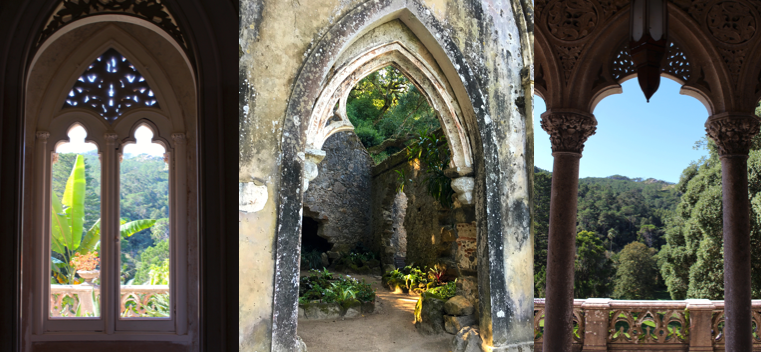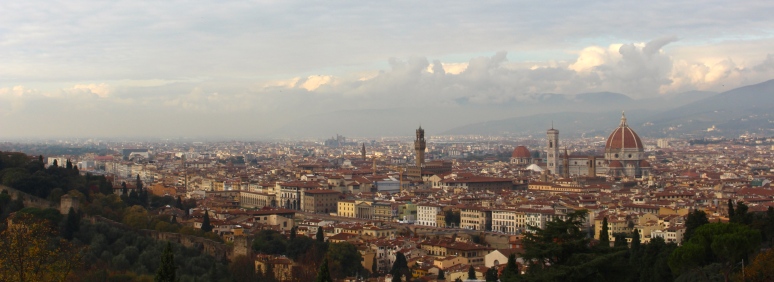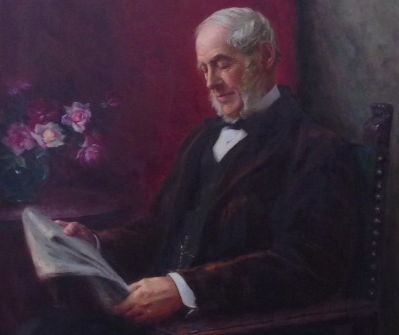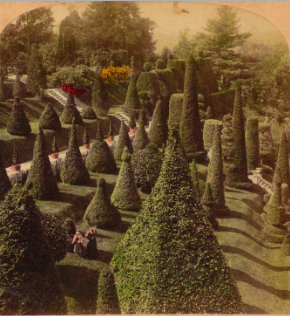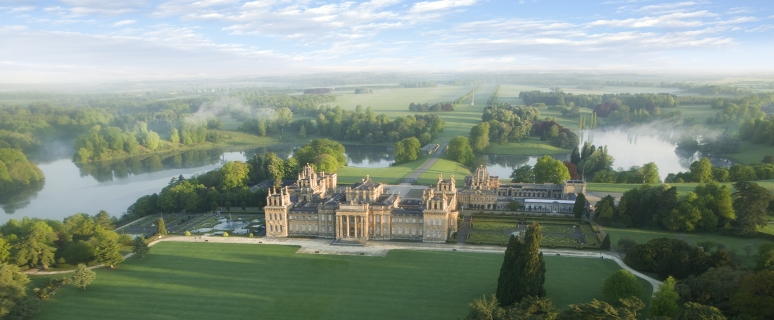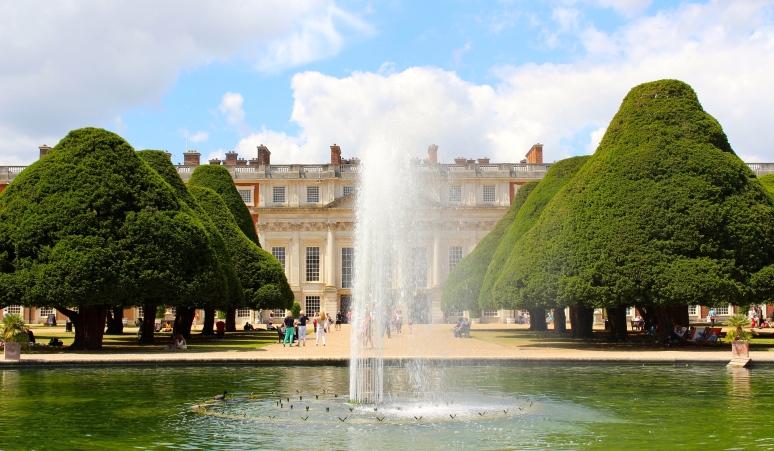The Gardens of Monserrate: Portugal

Located in the hills of Sintra, Portugal, the palace and gardens of Monserrate are truly magical. Reminiscent of childhood fantasies about exotic far away places, they were developed over centuries through the creative genius of multiple individuals and are described as one of the most beautiful landscapes created in the Romantic era in Portugal as well as the most important English landscape gardens beyond the British Isles.

View of Monserrate in 1840 Lithography by Manuel Luiz based on a drawing by Clémentine Brélaz. © Parques de Sintra-Monte da Lua, S.A.
I visited Monserrate in early October while on a two-week trip to Portugal. A world heritage cultural landscape, Sintra has for centuries served as a vacation destination for the Portuguese elite. Encompassing some of Portugal’s most important parks and monuments, including the Park and Palace of Pena, Sintra is often visited as a day trip from Lisbon although I chose to spend three days exploring the region.
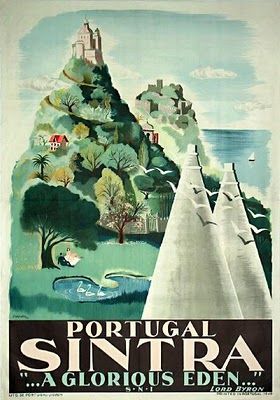
The history of Monserrate is as romantic as its landscape, a tale of creation, abandonment and rediscovery.

In 1540 a chapel dedicated to Our Lady of Monserrate was erected on the site, for which it is named. By the 17th century the property passed to the influential Mello e Castro family and by 1790 it was acquired by Gerard de Visme a wealthy merchant who built a neo-Gothic palace atop the ruins of the former chapel.

View of the property of Gerard de Visme (drawing by Noel, c.1790; print by J.Wells, 1795 – National Library of Portugal
According to a history of Monserrate, Visme’s gardens were remarkable and based upon an English model that differed from the baroque gardens favored in Portugal at the time. Most unusual was a preoccupation with the design of carefully considered views of “natural curiosities” including grottoes and streams. Artistic elements included an obelisk and a hermitage.

Enter William Beckford, an eccentric travel writer and the author of the gothic novel Vathek subtitled An Arabian Tale or The History of the Caliph Vathek. Beckford first visited the property in 1794 and during a fourteen year tenure at Monserrate created a romantic landscape in the “picturesque manner.”

At Monserrate Beckford is credited with diverting a stream on the property to create Beckford’s Waterfall, constructing Vathek’s stone arch (seen below) and numerous planting projects including the introduction of two stone pines planted on either side of the waterfall.

By 1809 the property had fallen into disrepair and Byron, a fan of the book Vathek, visited and wrote a poem describing what was by then an abandoned landscape. His romantic description of the palace and grounds as a ruin made Monserrate a popular destination for English visitors drawn to its decaying splendor.

In 1856 the Cook family purchased the property and it is they who are credited with transforming Monserrate into the extraordinary palace and gardens which exist today. A textile millionaire, Cook hired more than 2,000 men to work for more than five years to rebuild the house and gardens.

The Cook family and friends
According to a history published by the Parques de Sintra, Cook “wanted a house that would be visited twice a year, for periods of about a month, not a country house but a holiday home.” Cook’s palace combined Victorian influences with Italian gothic details, orientalism and Portuguese elements. The ornate interiors are beautiful and the palace, although currently devoid of furnishings, remains a work of art.


The Cook family lived at Monserrate for four generations. During their tenure the gardens were gradually landscaped in the picturesque manner and in harmony with the palace as distinct scenes “worthy of being painted.”

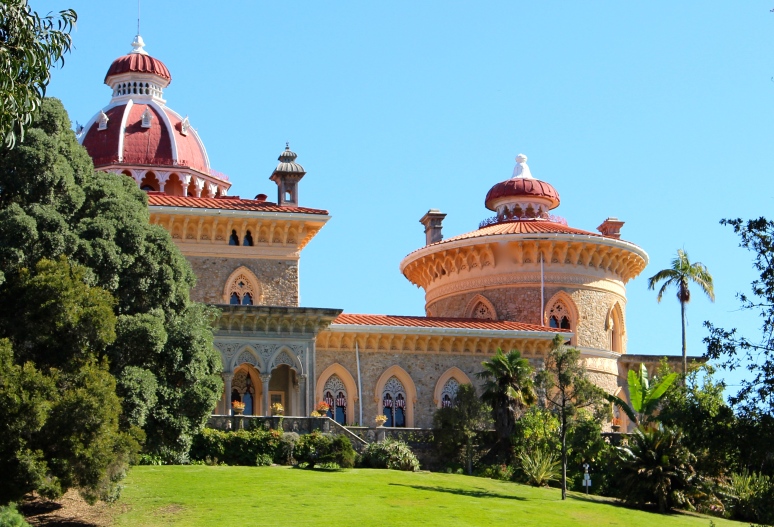
As one travels throughout the gardens the Palace remains a central and surprising visual feature emerging from multiple perspectives along the steeply sloped, densely vegetated, circuitous paths. The interplay of natural and formal elements is evident throughout.

A view of the palace dated 1866
Arriving at the garden one is greeted by two Chimera, fire-breathing mythological creatures that represent that which is hoped for but is illusory and impossible to achieve. They introduce the visitor to the “fantastic beyond the garden gates.”


Upon entering Monserrate there are few visual clues about which path to take and where the palace lies. I was drawn towards the sound of Beckford’s waterfall which led downhill to both the fern valley and chapel which was rebuilt by Cook as a “ruin” on the site of one built by Gerard de Visme to replace the former chapel of Our Lady of Monserrate.
This sequence is described in the guide as representing that of a wanderer who sets off on an unknown journey and is guided by nature itself.


Approximately 80 acres in size, Monserrate contains an extensive botanical collection from throughout the world that is showcased in a series of themed gardens that flourish in Sintra’s temperate climate.

Among these is a large Mexican garden containing collections of plants from warm climates including palms, yuccas, nolinas, agaves and cycads. Restored in 2010 it is in the hottest and driest part of Monserrate and is one of its largest.



I was drawn to a series of gardens located to the side of the palace and accessible from the porch. Here a series of steps leads to a path bordered by pergolas planted with wisteria and jasmine. 
An ornamental Indian Arch purchased in 1857 by Sir Francis Cook from Charles Canning, the Governor-General of India, leads from this area to the Boulder House which once housed a carpenter’s shop and cow shed and is now used as the head offices of Parques de Sintra-Monte da Lua.


Close by is the Cromlech, a term that describes prehistoric megalithic structures (think Stonehenge), which is attributed to Beckford.

In 1949, Monserrate was purchased by the Portuguese State and in 1995 it was included in the Cultural Landscape of Sintra, classified by UNESCO as a World Heritage Site.

In 2000 management of the estate was transferred to Parques de Sintra, which continues to restore the gardens and Palace. Their work was recognized in 2013 when the Park of Monserrate was awarded a European Garden Award under the category of Best Development of a Historic Park or Garden.
Copyright © 2016 Patrice Todisco — All Rights Reserved
Book Review: Women Garden Designers: 1900 to the Present

This summer I picked up a copy of the book Thoughtful Gardening by Robin Lane Fox, gardening columnist for the London Financial Times, in a remainder bin in a Camden, Maine bookstore. Published in 2010 it includes a series of 80 essays on a wide array of topics related to all things gardens, including one titled “Gendered Landscapes.” Fox’s conclusion, that the landscape is highly gendered but no one talks about it, begs the question; If women have been designing landscapes for centuries why are they so seldom acknowledged?

Niki de Saint Phalle’s grotto at Herrenhauser garden
Coincidentally, I acquired Women Garden Designers: 1900 to the Present by garden historian Kristina Taylor. Published in 2015, the book profiles thirty-one important and influential women garden designers from around the world presenting the gardens they designed for themselves, their professional work and their influence on landscape design.
Taylor’s book, which posits that women’s attitudes towards the land may indeed be different from that of men, is described as an examination of a particular women’s perspective of nature that has not been “quantified or qualified” and is offered as an examination of the work itself. Each of the thirty-one designers profiled is introduced as an individual, whose work is to be judged within its own context. Informed by extensive travel, research and, when possible, interviews, Women Garden Designers: 1900 to the Present provides a refreshing introduction to designers whose work shaped the modern landscape. While the book includes pieces on well-known American and English designers, including Gertrude Jekyll, Beatrix Farrand, Marian Coffin and Vita Sackville-West, its strength lies in the profiles of those women whose contributions to garden design are not as widely recognized.
Informed by extensive travel, research and, when possible, interviews, Women Garden Designers: 1900 to the Present provides a refreshing introduction to designers whose work shaped the modern landscape. While the book includes pieces on well-known American and English designers, including Gertrude Jekyll, Beatrix Farrand, Marian Coffin and Vita Sackville-West, its strength lies in the profiles of those women whose contributions to garden design are not as widely recognized.

Pond and landscape in the municipality of Araras by Isabel Duprat
Running throughout is the extraordinary connection between the designers and the natural world, with an emphasis on sustainability, ecology, native plantings and the idea of gardening as an “implicit, organic and instinctive art.” In 1947 Brenda Colvin, a founding member of the British Institute of Landscape Architects, wrote the ground-breaking book, Land and Landscape: Evolution, Design and Control. Joane Pim, described by Taylor as the doyenne of South African landscape design, wrote Beauty is Necessary: Creation or Preservation of the Landscape.

Women Garden Designers: 1900 to the Present is generously illustrated with color photographs and includes an extensive bibliography as well as links to relevant websites. It successfully integrates garden scholarship with readability and is compelling for both its erudite text and design.

Dame Sylvia Crowe designed the rose garden at Magdalen College in 1953 to commemorate the development of penicillin as an antibiotic in Oxford during the 1940’s.
As a celebration of the manner in which women garden designers create gardens and work in the landscape, Women Garden Designers: 1900 to the Present is a compendium of individual stories that, while singular, are connected through a slender thread, providing insight into what Taylor describes as the “unique and special approach to garden and landscape design” of the women profiled.

Niki de Saint Phalle’s “Nanas” along Hanover, Germany’s ring road are named for famous historical citizens
This review appeared in Leaflet A Massachusetts Horticultural Society Publication, October, 2016
Copyright © 2016 Patrice Todisco — All Rights Reserved
An Island Garden

In the world of celebrated American gardens there may be none more modest than that of Celia Thaxter on Appledore Island, ten miles off the coast of Portsmouth, New Hampshire. Just 750 square feet in size, the garden was immortalized in the book, An Island Garden, written by Thaxter and illustrated by American impressionist Childe Hassam in 1893, the last year of Thaxter’s life.

In the garden by Childe Hassam, 1892
Hassam was one of many artists and literary figures who summered on Appledore, where Thaxter’s family operated a popular summer resort. As Thaxter’s spiritual center, the island is where she cultivated her precious garden and a famous salon that attracted the writers and artists of her day.

I was drawn back into the world of Thaxter and Appledore when I visited the Peabody Essex Museum in Salem to view the exhibit, American Impressionist: Childe Hassam and the Isles of Shoals. On view until early November it features more than 40 oil paintings and watercolors painted by Hassam from the late 1880s to 1912 and is the first exhibition in more than 25 years to showcase Hassam’s island paintings.

In the off-chance you think twenty-five years is a long time, I happened to have seen that previous exhibition, Childe Hassam: An Island Garden Revisited at Yale University in 1990. At the time I was deep into Thaxter’s world researching By Pen and by Spade, published in the gardening journal Hortus. In the piece I chronicled the friendship of Thaxter and author Sarah Orne Jewett, examining the role that gardening and the New England landscape played in their evolution as regional writers.

Thaxter’s island cottage had a covered piazza that ran along its front with the garden located below. Surrounded by a board fence to keep out the ocean spray, the plan which illustrates An Island Garden lists 57 species of flowers and vines. These include sunflowers, hollyhocks, sweet peas and California poppies all gloriously illustrated by Hassam.

Island life wasn’t easy and Thaxter goes through great lengths to share how much work went into tending her precious garden. She battled slugs and snails, infertile soil and the challenge of transporting tender seedings from the mainland where she spent the winter months. Her solution for transporting poppies, which she dearly loved, was to plant them in egg shells for protection during the harbor crossing
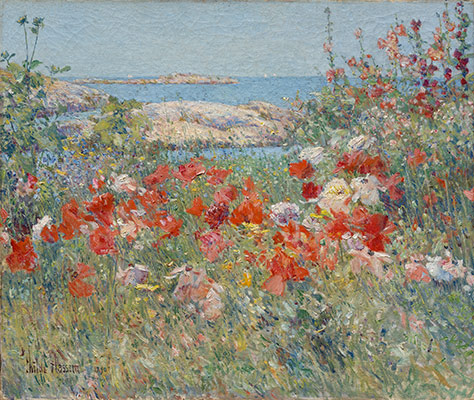
Celia Thaxter’s Garden, Isles of Shoals by Childe Hassam, 1890

With an abounding zeal, Thaxter arose early each morning to tend her garden and gather bouquets for her parlor while the dew was still fresh on each petal. She filled vases, bowls and baskets with flowers, creating arrangements on every conceivable surface in her parlor.

The Room of Flowers by Childe Hassam, 1894
Her reverence for her flowers was mystical and she described herself as both worshipping and being worshipped by them. Her romanticism ran so deep that even weeding was described in luminous terms, as an act of nearly erotic “pleasure.” I only wish that it were so.

Celia Thaxter picking poppies, c. 1892
Like her garden, Thaxter carefully cultivated her artistic persona, becoming the center of a literary and artistic circle that included invited guests. Along with Hassam, William Morris Hunt, Ellen Robbins, Nathaniel Hawthorne, John Greenleaf Whittier, Annie Fields and Ralph Waldo Emerson all spent time on the island.
Both the Appledore House hotel and Thaxter’s cottage burned in 1914, twenty years after her death and both Thaxter’s popularity and the island fell into decline.

The garden was reestablished, using dimensions provided by Thaxter, in 1977 through a joint effort of the The Shoals Marine Laboratory, the Rye Beach and Little Boar’s Head garden clubs and Cornell Plantations. In the preface to the edition of An Island Garden published in 1985 upon the 150th anniversary edition of Thaxter’s birth, this process is described by John M. Kingsbury a professor from Cornell who helped conceive The Shoals Marine Laboratory.

I visited Thaxter’s garden in the 70’s and my abiding memory is of the vast colonies of rather aggressive seagulls that nest there. Visiting the island has become a lot easier than my solo journey and tours can be booked through the Shoals Marine Laboratory at https://www.shoalsmarinelaboratory.org/event/celia-thaxters-garden-tours.

West Wind, Isles of Shoals by Childe Hassam, 1904
I’ve included a few links that include a downloadable copy of An Island Garden, photographs (mine in this piece have been converted from slides) and additional information.
http://www.pem.org/library/blog/?p=7453
http://digital.library.upenn.edu/women/thaxter/garden/garden.html
http://petererandall.photoshelter.com/gallery/Isles-of-Shoals/G0000vdh3_AIxX20/
Copyright © 2016 Patrice Todisco — All Rights Reserved
The Florence Greenway + The Bardini and Boboli Gardens
I’ve been saving and savoring the article “An Ancient Tuscan Farm Turned Magical Bohemian Home” from the June 27th issue of The New York Times Style Magazine. The piece tells the story of a 15 acre farm overlooking Florence that has been active since the Middle Ages. It reminded me of the day I spent visiting the Bardini and Boboli Gardens and exploring a greenway that is in the process of being developed on the periphery of the city.
Visiting Florence can be an overwhelming experience. Not only is there a magnificent work of art or architecture (or both) around every corner but it is also extremely crowded. If, like me, you are always looking for an easily accessible park or garden in which to recharge, in Florence you may be challenged to find one.
The Bardini and Boboli Gardens are destinations in their own right and are connected both physically (with a path through the Forte di Belvedere) and through a shared admission fee.
The greenway, which I discovered while at the Bardini Garden, provides something quite different – a new way in which to experience the city and view both gardens as cultural landscapes integral to its historic fabric.
Portions of the greenway follow the city wall and walking its route the natural world coexists in close proximity to the city’s medieval core.
The greenway map below is from the guide to the Bardini Garden and uses that site as a starting point. The guide describes the greenway as an opportunity to follow the mineral and stone deposits within the city and as an alternative to the tourist network whose “mesh gets ever tighter.”
Occupying a steep hill overlooking Florence, the Bardini Garden has a storied history as a private estate that has been owned and managed by the Bardini family since 1913. Its original use as a garden is described as a “hortus conclusus” or an enclosed area close to the house used primarily as an orchard.
As the property evolved its rural character was formalized with gardens designed and redesigned to reflect the changing tastes of its owners. Architectural features that were added include a rustic grotto, belvedere, theater and Kaffeehaus.
By the 19th century a portion of the Giardino Bardini was transformed into an Anglo-Chinese garden and is described as featuring a lake, waterfall, fountain, and a Kaffeehaus with a round salon and grotto. One if the garden’s most prominent features, a dramatic staircase from the terrace below the palazzo, connects the Belvedere to the Piazza Dei Mozzi.
With a spectacular view of the city below, the garden has been included in guidebooks to Florence. Restoration on the garden began in 2000 and today it is admired for its extensive botanical collection which is designed thematically to provide seasonal interest.
The neighboring Boboli Gardens, through which the greenway passes, are named for the wooded area adjacent to the city’s ramparts they once occupied.
Located behind the Pitti Palace, the 111 acre garden’s tree-lined allées, formal spaces, fountains, sculptures and woodlands are described as the greatest open-air museum in Florence.
A testament to royal garden making at its finest, for more than 400 years the Boboli Gardens have been designed and redesigned beginning with the early partnership of Eleonora of Toledo, wife of Duke Cosimo I de’ Medici and artist Niccolo Pericoli, known as “Il Tribolo” whose design was realized, to a large degree, by successive overseers including Giorgio Vasari.
Within the Boboli Gardens are multiple structures including several grottos, a lemon house, a Kaffehaus and the Knight’s Garden and Lodge. The Lodge’s garden, designed by Michelangelo in 1529, includes medicinal plants. The Lodge, a meeting place for scholars and scientists until the late 18th century, houses the Porcelain Museum.
Staying within the Boboli Gardens, one can follow the Florence Greenway to the highly ornate Island Pond, with its plethora of statuary each depicting a mythological scene. The surrounding area contains nearly 200 potted citrus trees and an ancient rose garden surrounded by flower beds.
From there the aptly named Meadow of Columns leads to an entrance gate.
Should one walk outside of the Boboli Gardens along the Via Romana there is an opportunity to visit some of the green spaces in the neighborhood including the Corsi Annalena Garden, the first example of a Romantic Garden in Florence. Close by is the Torrigiani Garden, the largest private European Garden built within the walls of a city. Both are open by appointment.
Passing through the Porta Romana, the gate to the city, one can either pass through the Royal Stables, now the State School of Art, or enter directly onto the Viale Niccolo Machiavelli, a circuitous tree-lined boulevard that passes through a series of residential neighborhoods.
The Viale Machiavelli has a gracious sidewalk and along its route are several public parks.
A landmark of sorts along the route is the Piazzale Galileo after which one follows the Viale Galileo which leads to the Basilica di San Minato al Monte (Basilica of St. Minias on the Mountain) described as the finest Romanesque structure in Tuscany. It sits atop one of the highest points in Florence.
Close by is the popular tourist destination Piazzale Michelangelo.
While most appear to drive to the Piazzale Michelangelo, where there is ample parking, one can continue their journey on the greenway down a series of steps where they will reconnect with both the city walls and the Bardini Garden.
The Florence Greenway is several kilometers in length and one can easily spend a day following its route.
When I was there directional signage had yet to be installed and for a good part of the greenway there wasn’t a tourist in sight.
Walking the Florence Greenway provides an unparalleled opportunity to explore the city in a new way. While many cities strive to create such an experience in Florence it already exists and the only secret is finding a map of its route.
Copyright © 2016 Patrice Todisco — All Rights Reserved
Book Review: Onward and Upward in the Garden by Katharine S. White
In 1958 as her job as an editor at The New Yorker was coming to close, Katharine S. White penned a gardening column entitled “Onward and Upward in Garden,” the first in a series of fourteen pieces that would run in the magazine over a twelve year period. Compiled and published with an introduction by her husband E.B. White two years after her death in 1977, Onward and Upward in the Garden was reissued as a New York Review Books Classic in 2015, the second garden book to be so honored.
I have returned to Onward and Upward in the Garden frequently and it is a book that I recommend for any season, particularly the dog days of August. There’s not a picture within its pages and each piece can be read and savored on its own merit. As White notes in its concluding essay, there are few American books that deal with horticulture and plants as a true branch of literature. Her pieces for The New Yorker achieved both, providing pleasure to not only gardeners but any other reader.
A traditionalist, White’s tastes were, like her writing style, simple and direct. She grew up in Brookline, Massachusetts and gardened in Maine. With a sensibility shaped by her New England heritage, White preferred the “plain to the fancy, the relaxed to the formal, the single to the double, the medium sized to the giant.”
The book’s title, Onward and Upward in the Garden, is borrowed from a Unitarian phrase and underscores the pragmatic approach White favored in her exploration of the gardening world. Nothing fancy or unnecessary, please. Included within are chapters devoted to the history and literature of gardens, the arranging of flowers, herbalists, seed catalogues, and garden trends and developments.

Katharine S. White viewing eyes a colorful flower bed at the Whites’ farmhouse in Brooklin, Maine from The Ellsworth American, 3/21/2015.
For White the garden was a world where the practical intersected with the intellect and the catalogues of seedsmen and nurserymen (described as her favorite reading matter) were as worthy of consideration as those of historians and botanists. She wrote extensively about current publications including a piece from 1962 in which she reviews the book, Her Garden Was Her Delight, breaking new ground and based upon the promising idea that “little-known women gardeners, botanists, botanical artists, plant collectors and garden writers have played a part in the horticultural history of our country.” How far we have come.
White is described in the book’s introduction as owning no gardening clothes and more likely to visit her garden in a pair of Ferragamo shoes than work boots. Once a year, in a ceremonious manner, she donned a shabby Brooks Brother raincoat and on a fall day oversaw, with military precision, the laying out of the spring bulb garden described as “a crucial operation, carefully charted and full of witchcraft.”

E.B. White, his wife, Katharine, and their dog, Minnie, at their farm in North Brooklin. Courtesy of White Literary LLC
Witchcraft or not, in the introduction E.B. White notes that his beloved Katharine aspired to author a garden book but wished to write one more piece – a reminiscence of the gardens of her childhood. While this final piece, unachievable due to ill health was never realized, Onward and Upward in the Garden serves as her legacy to the canon of American garden literature.
For additional reading: http://www.ellsworthamerican.com/living/home-garden/book-called-a-heady-compost-of-observation-taste-wit
Onward and Upward in the Garden by Katharine S. White.
Edited with an introduction by E.B. White.
New York Review Books Classics: 2015.
This review appeared in Leaflet A Massachusetts Horticultural Society Publication, August, 2016
The Hunnewell Estate: Wellesley
It’s not often that I visit private gardens and even less often that I visit those best known for their topiary (despite the fact that I wrote about the Ladew Topiary Gardens in my last post).
However, when I discovered that Tower Hill Botanic Garden was offering a tour of the Hunnewell Estate in Wellesley I decided to attend, having admired its picturesque front lawn and entry drive on my visits to Elm Bank, home of the Massachusetts Horticultural Society which is just across the road.
The estate is a rare, surviving example of its type; a comprehensive ensemble created and owned by the same family for more than one hundred and fifty years. Once regaled as a fine example of a model country place in the style of A.J. Downing, it has retained its design integrity and remarkable collection of trees. Visiting was a special treat.
Described in a New England Historical Society article as a “railroad baron and garden nut,” Horatio Hollis Hunnewell was born in 1810 and began work on his estate in Wellesley in the 1840s. Enamored of rural life, Hunnewell spent decades planning, planting, expanding and improving the property.
In 1854, three years after the house, designed in the renaissance revival style by architect Arthur Gilman was built, Hunnewell began work on the Italian garden. Containing a series of seven terraces on a seventy-five foot bluff overlooking Lake Waban, it was inspired by the gardens at Elvaston Castle in Derbyshire, England.
Since the time of Pliny the Elder (1st century AD) topiary, the art of shaping trees and shrubs, has been practiced in various forms. Hunnewell’s use of topiary in his Italian garden is credited with being the earliest in the United States and the geometric shapes he favored were executed with species of trees cross-bred to thrive in New England’s harsh climate.
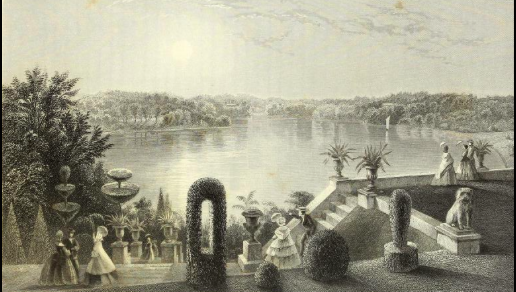
Italian Garden and Lake at Wellesley near Boston, ca.1830 by JD Smillie for A Treatise on the Theory and Practice of Landscape Gardening, 8th edition by A.J.Downing.
Hunnewell’s Italian garden included a pavilion and a series of steps, ornamented with statuary and urns with a lakeside promenade. In 1865 Hunnewell built a boathouse to house an Italian gondola.
As far as topiary is concerned (and here I add that an expert I am not) Hunnewell favored geometrical shapes and forms including cones, spheres and pyramids rather than representations of birds and animals.
The image below, taken from a stereoscope by J.F. Jarvis is titled “The artist’s dream: Hunnewell’s grounds, Wellesley, MA., USA. It’s all rather pointy and looks rather like a cross between Alice in Wonderland and Dr. Seuss.
Maintaining topiary is a labor intensive task and at one time five men spent two months each year on ladders, held by hand to trim the trees in the Italian garden. Today this job is undertaken by the current garden staff with the assistance of family members.
Committed to the advancement of horticulture, Hunnewell had one of the largest and diverse collections of conifers in the United States. He was nationally recognized for his experiments with trees and woody plants including the now ubiquitous rhododendron, which he introduced to New England and sponsored an exhibition of on the Boston Common in 1873.
Befitting an operation of its scale, the Hunnewell estate included other gardens and features including a formal french style garden adjacent to the house (now removed). We had an opportunity to visit the conservatory where trained nasturtium vines encircle the doorway.
One cannot help but to be deeply impressed by the vision and dedication that Hunnewell brought to his horticultural pursuits. A lifelong supporter of both the Massachusetts Horticultural Society and the Arnold Arboretum, Hunnewell was a passionate advocate for both institutions. His strong sense of stewardship for the landscape and collections of his estate has been carried on by subsequent generations and today the property is protected with a conservation restriction by the Trustees of Reservations.
One last note on the name. The property was originally named Wellesley, in honor of Hunnewell’s wife’s family. When both the neighboring Wellesley College and the town, of which Hunnewell was a generous benefactor, adopted the name there was a bit too much “Wellesley” and it is now referred to as the Hunnewell Place/Estate/Property.
Please note that the Hunnewell Estate garden will be open to the public through the Garden Conservancy’s Open Days program on Saturday, August 13, 2016 from 10-2 pm.
Copyright © 2016 Patrice Todisco — All Rights Reserved
Book Review: All the Presidents’ Gardens: Madison’s Cabbages to Kennedy’s Roses – How the White House Grounds Have Grown with America by Marta McDowell
If in this year of presidential politics you yearn for a different perspective on life in the White House, All the Presidents’ Gardens: Madison’s Cabbages to Kennedy’s Roses – How the White House Grounds Have Grown with America by landscape historian Marta McDowell provides the perfect antidote.
Revealing the story of how the Presidents and their families have shaped the eighteen-acre landscape which comprises the White House grounds, the book provides both a refreshing and revealing account of what is the nation’s “first garden” and begs the question, depending on who is elected in November, what’s next?
McDowell, a consummate storyteller, is without political bias relying instead on the politics of plants to provide “common ground” and serve as the focus of the book’s narrative. A backdrop for the nation’s history since 1800, the White House grounds are both a public space for pageantry and protest and a private space for refuge and reflection. Each presidential family has left its imprint and each has a story to tell.
Beginning with the founding of the capital by the somewhat “plant-crazy” George Washington, who sited the executive mansion on a rise for a good view, McDowell traces the history of the White House grounds within the context of the American horticultural movement. Its first plant list, an order for specimen trees including species native to America to line a formal entrance approach to the executive mansion, was placed by James Madison in 1809.
The cultivation and ceremonial use of trees plays a central role throughout, including the history of Washington, DC’s iconic cherry trees. While John Quincy Adams answered “the great ends of his existence” by growing chestnuts and elms and establishing the nation’s first forestry project, Eliza Scidmore, described as an “unpaid but determined garden lobbyist,” vigorously pursued her vision for the planting of cherry trees along the tidal basin.
And speaking of trees, in the chapter “All the Presidents’ Plants”, McDowell includes a list of trees, shrubs and vines grown on the White House grounds based upon inventories conducted in 1809, 1900 and 2008. The plant list includes the botanical name, cultivar, whether the plant is native to the lower 48 states and information about the time frame in which the plant grew.
Additional sections provide background information about the White House gardeners (The Men Who Planted for Presidents), recommended reading, sources and citations. Historic documents, maps and photographs generously illustrate the text, which deftly balances its breadth of scholarship with the freshness of McDowell’s style and depth of enthusiasm for the subject at hand.
In its final chapter, “Is Green the New Red, White and Blue?,” All the Presidents’ Gardens: Madison’s Cabbages to Kennedy’s Roses – How the White House Gardens Have Grown with America comes full circle as Michelle Obama breaks ground on the Kitchen Garden. Planted with more than 50 varieties of vegetables (including some grown from seeds from Monticello), berries and herbs, the garden brings local food, in the tradition of past administrations, back into the White House kitchen.
Irvin Williams, head gardener from 1962 – 2008, is quoted as saying, “What’s great about the job is that our trees, our plants, our shrubs, know nothing about politics.” A felicitous thought indeed.
The White House grounds are open to the public twice a year. Information can be found at http://www.whitehouse.gov in the statements and releases section.
All the Presidents’ Gardens: Madison’s Cabbages to Kennedy Roses – How the White House Grounds Have Grown with America by Marta McDowell Timber Press: Portland, Oregon, 2015.
.
This review appeared in Leaflet A Massachusetts Horticultural Society Publication, June, 2016
Ladew Topiary Gardens
“Never be under the weather, there are so many other places to go.”
Thus was the philosophy of Harvey Smith Ladew (1887-1976) creator of the Ladew Topiary Gardens in Monkton, Maryland, considered by the Garden Club of America as “the most outstanding topiary gardens in America.”
A lifelong bachelor and renaissance man Ladew was, among other pursuits, an American horticulturist, golfer, painter, socialite, decorator, collector, writer and avid fox hunter. Born into a wealthy New York City manufacturing family his youth was one of privilege, enriched by international travel and artistic pursuits. As an adult Ladew merged his interests in the design of his home and gardens.
Drawn to the Maryland countryside for its equestrian culture, Ladew single-handedly transformed a rather unremarkable farmhouse into a 22-acre garden that is both a whimsical homage to famous gardens of the world and a serious horticultural endeavor. He was a master of detail and a collector of ornament integrated by a sophisticated design sensibility.
Ladew purchased Pleasant Valley Farm in 1929 and for 47 years worked on both the house and gardens, creating a backdrop for a life devoted to pleasure. An adventurer who socialized with a sophisticated crowd, including Lawrence of Arabia, decorator Billy Baldwin, and the Prince of Wales, Ladew brought the same sensibility of discovery, albeit on a more intimate scale, to his country estate.
His oval library, seen below, was described as one of the most beautiful rooms in America and contains more than 3,000 volumes of modern first editions including biographies, art and gardening books, French literature and travel guides. 
While Ladew’s motto was “play now, work later” he clearly worked passionately to design and maintain his gardens, thoughtfully assuring their continuation after his death. Drawing inspiration from gardens throughout the world, each and every one of the garden “rooms” he designed bear his imprint. Gardening was for Ladew a highly personal endeavor.
Ladew’s garden “master plan” began with the creation of the “great bowl,” a sweeping expanse of lawn north of the house embellished with an oval swimming pool. Enclosed by high hedges of hemlock and yew and accented with twelve topiary swans, today the great bowl serves as a venue for garden concerts.

Harvey Ladew trims up a swan in his garden in 1957 from: http://retrobaltimore.tumblr.com/post/97675970829/now-and-then-pictures-ladew-topiary-gardens
Familiar with famous gardens throughout England and Italy, Ladew drew inspiration from their designs, combining formal and informal elements that are both intimate and public. Two cross axis allow for uninterrupted vistas while a series of 15 garden rooms, each devoted to a single color, theme or plant are sited off the main axis.
Ladew reportedly visited and was influenced by Hidcote and is credited with being one of the first Americans to develop gardens designed in this manner within the United States.
In 1971 he was awarded the Garden Club of America Distinguished Service Medal for developing and maintaining the most outstanding Topiary Garden in America without professional help.
I visited at the end of April when the dogwoods, azaleas and spring bulbs were in full bloom. As is often the case with gardens, I walked through once and then proceeded to do so again backwards, seeing completely different things. The more I looked the more impressed I was both with Ladew’s sense of design and his horticultural sensibilities.
The plan below is from the guidebook, The House and Gardens of Harvey S. Ladew written and designed by Dee Hardy.
A Quick Garden Tour: It’s here that I use my editorial judgement to share my favorite garden rooms and details, a challenging process as there are many. To see them all visit the Ladew Gardens webpage where you will also find a listing of events.
The Woodland Garden serves as a transition between the visitor center and house. The garden’s curved pathway provides an informal entrance to the rooms beyond and really is quite modest given the extent of the garden. A centrally placed dovecote is but one of many ornamental features, emblematic of Ladew’s attention to detail, sited throughout the garden
While the Berry Garden was designed by Ladew as a fall and winter attraction for birds, its sense of enclosure, views to and from the house and larger landscape and simple, formal design serve (from my perspective) as the formal forecourt to the gardens beyond.
The photo below is of the Pink Garden a transitional space between the Croquet Court and Rose Garden. It is planted with crab-apples, birch, dogwood, smoke bushes, Fairy and Carefree roses, astilbe, weigela, rhododendron, zinnias, snapdragons and bleeding hearts.
To enter the Garden of Eden one passes through an arch and over steps engraved with the Chinese proverb, If you would be happy for a week, take a wife, If you would be happy for a month kill a pig, But if you would be happy all your life, plant a garden.
I was fortunate to visit when the azaleas, which Ladew carefully selected, were in bloom. Appropriately the garden contains a statue of Adam and Eve nestled in the shrubbery (with Adam hiding an apple behind his back).
The Keyhole Garden is a curious space, bringing to mind images of Alice in Wonderland. Containing chess pieces, it is planted in shades of red.
Described as cool and serene, the Water Lily Garden serves as a central forecourt, connecting to the Topiary Sculptures and a series of other smaller, more intimate spaces within the gardens.
The 250-foot long Yellow Garden was inspired by Gertrude Jekyll and features tall chartreuse chamaecyparis and golden privet framing a stream flanked by yellow tulips.
Accessed from a terrace contiguous to the “great bowl,” the Iris garden includes a topiary Chinese junk floating in a pool. The garden features 65 varieties of iris. A Chinese gateway leads to a lawn providing access to the main house and the 1.5 mile nature walk, opened in 1999.
The gardens contain various and assorted structures, each uniquely and exquisitely crafted to complement the landscape setting.
The Temple of Venus (above) terminates the garden’s long vista while the Tivoli Tea House was created from the former façade of the Tivoli Theatre ticket booth in London. During my visit the interior of the tea house was being restored. Within is a framed window labeled “Ever Changing Landscape” that pays homage to Ladew’s vision.
Open seasonally the Ladew gardens offer a comprehensive educational program. On my visit, which was during the week, there were school groups and families exploring the garden and nature trail. I’d like to think that Ladew would take great pleasure in this fact, knowing that through his careful planning and creative genius his gardens have endured and are enjoyed today.
There is a studio (where Ladew painted) and a barn gallery which is used for special exhibits. His stables have been converted into a cafe.
The Gardens, Manor House and Nature Walk are open daily from April 1 through October 31 from 10:00 am – 5:00 pm.
The Gardens, Manor House and Nature Walk are open Memorial Day, 4th of July, and Labor Day – same hours as above.
Copyright © 2016 Patrice Todisco — All Rights Reserved
Year of the English Garden
2016, the tercentenary of Lancelot ‘Capability’ Brown’s birth, has been declared the year of the English Garden. A nationwide festival, celebrating Brown’s legacy, is underway with lectures, walking, cycling and garden tours, exhibitions and conferences offered throughout the year.

© Portrait of Lancelot ‘Capability’ Brown, c.1770-75, Richard Cosway (1742-1821)/Private Collection/Bridgeman Images.
Described as the ‘Shakespeare of gardening,’ Brown is credited with transforming England’s aristocratic gardens from the formality of the Baroque period into the picturesque landscapes identified with England today; a combination of sweeping lawns, naturalistic plantings and endless views reflected in serpentine rivers and flowing lakes.
Brown worked on an immense scale designing gardens, parklands woodlands and carriage drives. Of the more than 250 landscapes attributed to Brown 150 retain their integrity today, including 42 within Greater London. Within Brown’s portfolio of projects are Richmond Gardens/Kew, Blenheim Palace, Highclere Castle (the setting of Downton Abbey) Longleat, Stowe and Hampton Court Palace where Brown was named the King’s Master Gardener in 1764.
Having declared 2016 the Year of the Royal Garden, Hampton Court Palace will, until September 4th, display a rare and never before seen collection of watercolor paintings and drawings once owned by the Empress Catherine the Great of Russia detailing views of the palace, park and gardens during Brown’s tenure. June 6th through 8th Hampton Court Palace will host the garden history and heritage conference, Capability Brown Royal Gardener – the man and his business: Past, Present and Future.
A four day Tercentenary Conference sponsored by the Cambridgeshire Gardens Trust and The Gardens Trust will be held at Robinson College, Cambridge from August 5th through the 7th while the ICOMOS International Scientific Committee on Cultural Landscapes, Garden History Society and National Trust will host the international conference, Capability Brown: Perception and Response in a Global Context at the University of Bath from September 9th through the 11th.

The historic Longleat House set in parkland landscaped by Capability Brown in the 18th century: Credit Visit England & Longleat House
As part of the National Garden Scheme, which since its inception has donated more than £45 million to its beneficiary charities, 3,800 gardens throughout the country will be open to paying visitors until late October. The National Garden Scheme has partnered with the Capability Brown Festival to offer access to Brown landscapes, including some that are otherwise inaccessible.

The East Lake Pavilion at Stowe, Buckinghamshire. Stowe is an 18th century landscaped garden, and includes more than 40 historic temples and monuments: Credit NT Images & Andrew Butler
Other events promoting the English garden include London Parks and Gardens Trust Open Squares Garden Weekend on the 18th and 19th of June. 200 private gardens across 27 London boroughs will be open to the public including community gardens and private squares.
If you go be sure to visit the following websites where you can track interactive maps of parks and gardens and the dates when they are open to the public.
Capability Brown Festival: www.capabiltybrown.org
National Garden Scheme: http://www.ngs.org.uk
London Parks and Garden’s Trust: http://www.londongardenstrust.org
Book Review: Oxford College Gardens
While staying in London last June I took the train to Oxford to visit the Botanic Garden. It had been nearly thirty years since I was last there and I had fond memories (and somewhat fading slides) of the garden, the Broad Walk and Christ Church Meadow, a riverine environment that for me at the time embodied all that is special about the English landscape.
The Botanic Garden, founded in 1621, is the oldest in Britain and easily found. Not so the myriad assortment of gardens and landscapes hidden behind the perimeter walls of the 38 self-governing, financially independent colleges which comprise the University.

Merton College, Oxford. Ceanothus trained on wall: c/o Frances Lincoln, an imprint of Quarto Publishing Group
In Oxford College Gardens landscape historian Tim Richardson shares the secrets of what lies behind those storied walls. It is here that the physical fabric of the University, informed by the synergy of its of landscape and architecture, has been shaped by time and the imprint of those who have lived and worked in each college.
While every college is distinct, informed by its own history and character, at the heart of each is the landscape; lawns, private ‘fellows’ gardens, groves, walks, meadows, lakes and deer parks. These are shared with the reader through Richardson’s lively text and brought to life by Andrew Lawson’s full-color photographs. Maps, historical images and contemporary plans of each college are also provided.
The breadth of garden styles portrayed within Oxford College Gardens is sweeping, ranging from the conventional quadrangles of University, Merton and Balliol Colleges to the modernist landscape of Saint Catherine’s College, designed by Danish architect Arne Jacobsen as a “landscape with buildings set within.” Eschewing judgement as to their design or landscape history, Richardson presents colleges alphabetically, beginning with the aptly named All Souls and concluding with Worcester College.
Special attention is paid to the gardeners who over time have both designed and lovingly tended individual college landscapes including Balliol head gardener Christopher Munday who in 2013 propagated a vivid magenta dahlia specimen to celebrate the college’s 750th anniversary which can be seen today in the college’s front quad herbaceous border.
George Harris, head gardener of Saint Hugh’s, is quoted upon his retirement in 1972 after 45 years of service as responding to the sentiment that the garden would never be the same without him, “You can’t expect it to be.” An appendix provides a list of head gardeners as of 2014.
At more than 300 pages in length Oxford College Gardens is a large book, just over 5 pounds in weight. Would that it were smaller and could serve as a guide to carry when visiting the spaces it depicts with such grace and erudition.
That said, there are many who will enjoy this compendium of all things Oxford, a place where “windows open onto other worlds” including its gardens.
Oxford College Gardens by Tim Richardson with Photographs by Andrew LawsonFrances Lincoln Limited, London: 2015
This review appeared in Leaflet A Massachusetts Horticultural Society Publication, April, 2016.
-

-
Recent Posts

Categories
- Book Reviews (23)
- Boston/Cambridge (14)
- Botanic Gardens (15)
- Gardens (58)
- Landscape History (56)
- London (12)
- Lugano/Morcote (2)
- New England Gardens (12)
- Parks (24)
- Public Realm (18)
- Squares/Plazas (6)
- Uncategorized (1)

Top Posts & Pages

Tags
American gardens Andre Le Notre Angell Memorial Park Arthur Schurcliff Barcelona Boston Boston/Cambridge Boston Common Boston Marathon Botanic Gardens Browne Fund Christopher Columbus Park Gardens Gertrude Jekyll High Line Italy Japanese Gardens Kadriorg Park Kelleher Rose Garden Linnaeus London London Parks & Gardens Trust MA New England Gardens New York City Ogden Codman Oxford Botanic Garden Paris Park Güell Parks Public Realm Ramler Park Rose Kennedy Memorial Rose Garden saint john's lodge Sweden Switzerland The Regent's Park UNESCO Versailles Villa Gamberaia

Kensington Gardens: Italian Garden
GWA Silver Award of Achievement for Best Overall Blog 2015


As featured in:




USE of PHOTOS + TEXT
Excerpts and photos may be used provided that full and clear credit is given accompanied by a link to www.landscapenotes.com.



